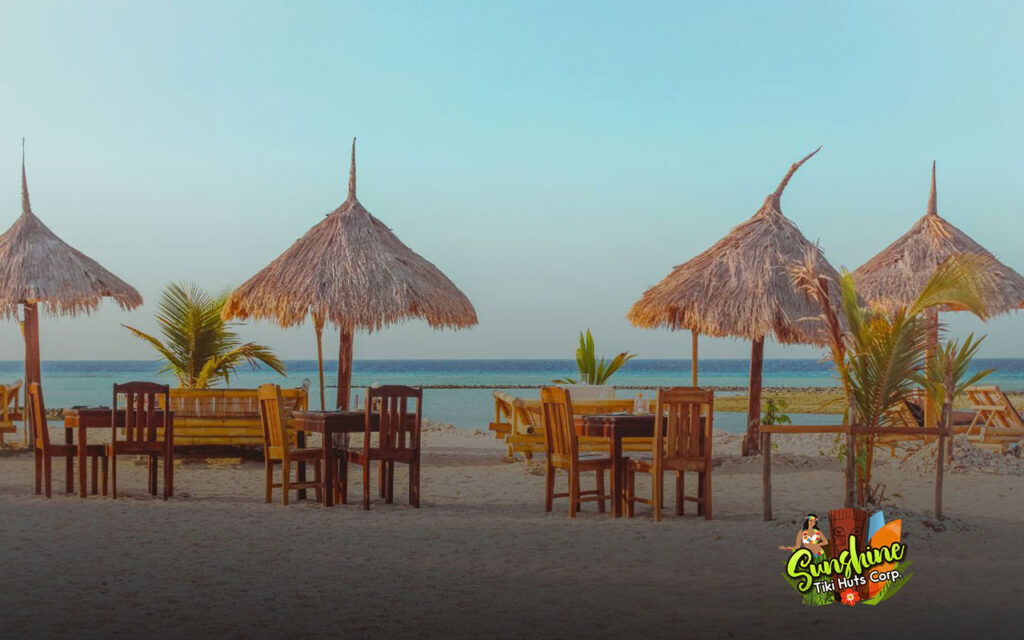Durability and style are paramount when selecting the perfect tikti bar roof material. Ideal roofing should withstand various weather conditions while enhancing your tiki bar’s aesthetic.
This guide offers insights into the most suitable materials, ensuring your outdoor space remains functional and inviting. Let’s explore the options that combine longevity with tropical flair, making your tiki bar the highlight of any gathering.
Essential Roof Materials to Consider
Natural Choices for an Authentic Look
- Palm Leaves: Often the first choice for traditional tiki bars, palm leaves offer a natural and tropical look. They’re lightweight and can be easily replaced, making maintenance straightforward. Furthermore, their natural insulation properties help keep your bar cooler on warm days, essential in sunny climates.
- Bamboo: Another popular option, bamboo enhances the aesthetic appeal and provides remarkable sturdiness. It adds a rustic charm to your tiki bar while offering good resistance to weather conditions. Moreover, bamboo is considered a sustainable choice, as it is quickly regenerated after harvesting, thus supporting environmental sustainability.
Synthetic Alternatives for Longevity
- Thatch Rolls: Synthetic thatch offers the look of traditional palm or grass but with significant added benefits. It provides durability and resistance to mold, pests, and fire, making it an excellent choice for wetter climates, as it does not rot or harbor insects. Additionally, synthetic thatch requires minimal maintenance, ensuring your tiki bar looks great with less effort.
- Corrugated Metal: Corrugated metal can be utilized for a more modern take. Additionally, it’s highly durable, offers excellent protection from the elements, and comes in various colors. Although not traditional, it provides a sleek contrast to the organic materials typically used in tiki bars and can be a striking feature of modern tiki design.
Combining Materials for Unique Designs
Creatively mixing wood shingles with palm leaves or bamboo can create a distinctive look while optimizing the roof’s functional properties. Also, this approach allows you to tailor the appearance and functionality to your specific needs and local weather conditions. Moreover, combining different materials enhances your tiki bar roof’s structural integrity and aesthetic diversity.
Quick Tips for Choosing Tiki Bar Roof Material

- Consider the climate: Choose materials that will suit your local weather.
- Think about maintenance: Opt for materials that are easy to clean and replace.
- Assess sustainability: Select resources that are environmentally friendly and renewable.
- Visual appeal: Ensure the materials complement your tiki bar’s overall design.
- Cost-effectiveness: Evaluate the long-term savings offered by more durable materials compared to the initial investment.
FAQ
Q: How often should tiki bar roof materials be replaced?
A: Natural materials like palm leaves may need replacement every few years, whereas synthetic options can last much longer, depending on the environment and care.
Q: Can I install these materials myself?
A: Many tiki bar roof materials are DIY-friendly. However, for the best results and safety, professional installation is recommended.
Q: What is the most cost-effective roofing material?
A: Bamboo often emerges as a more affordable option. It balances cost, appearance, and longevity effectively, offering excellent value for money.
Wrap Up Your Tiki Bar Project with Confidence
Choosing the suitable tiki bar roof material is crucial for both the durability and the aesthetic of your outdoor entertainment space. You ensure your tiki bar is beautiful and resilient by considering natural options like palm leaves and bamboo or synthetic alternatives like thatch rolls and corrugated metal. Furthermore, remember that the best choice depends on your needs, local climate, and design preferences.
Contact us today to explore our range of tiki bar roof materials and start building your dream tiki bar!

